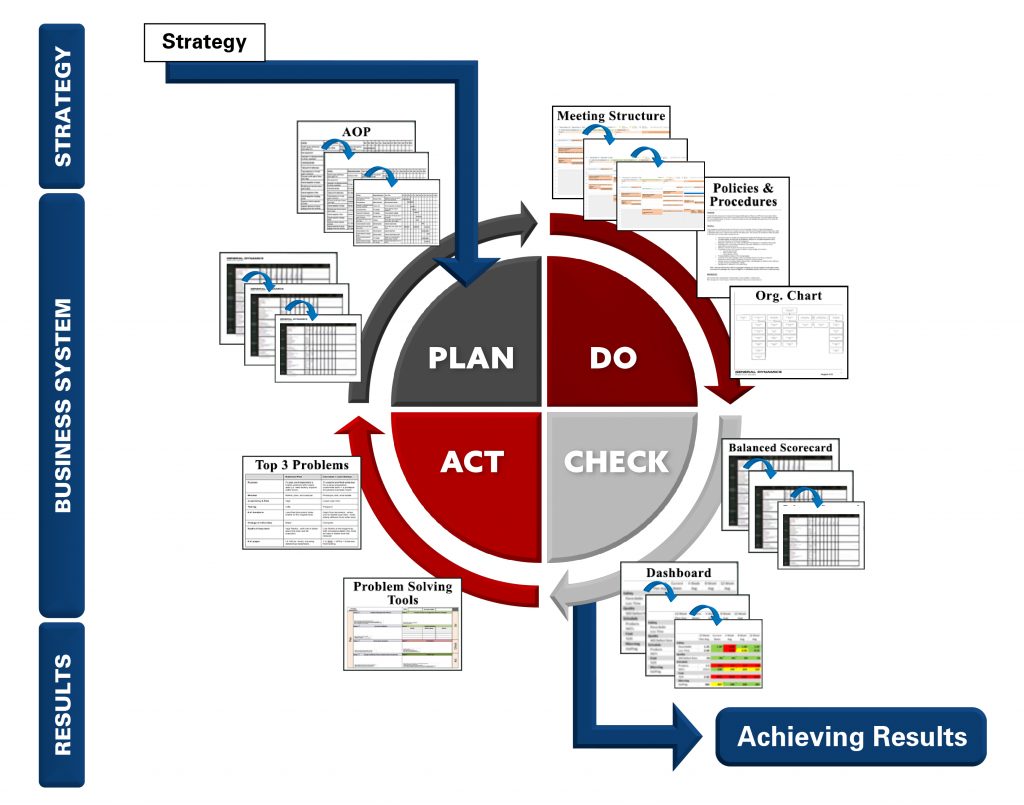[Post by Chuck Krugh, January 6, 2023]
Welcome back! I hope you have had a great holiday season and that you had some fun, got some rest and enjoyed some quality family time.
It’s time to finish our overview of the Business Operating System (BOS). We’ve traveled through one Plan-Do-Check-Act (PCDA) cycle explaining what each quadrant does and highlighting the supporting documents used in each part. Now we have three more elements to discuss covering the mechanics of our BOS: the continuous or ongoing flow of the business cycle, how the BOS cascades within our company and, last, the results of using the BOS.
As you look at the PDCA model that we use as a basis for the BOS, the circle of arrows that flow from each of the quadrants and their direction illustrate that it is a continuous cycle. In other words, it doesn’t end; the cycle continues much like our company does – day after day, week after week. Because the PDCA model is continuous, it applies to all parts of our operations. It works for assembly, accounting, engineering, maintenance and our other departments. The power of our PDCA model is that it can be applied to any part of our business.

Since the PDCA cycle is the basis of our Business Operating System, our BOS can be applied or deployed throughout the company: both across and within all departments. By adding some arrows on the tools, we show how the BOS functions vertically within the different levels of company or a department. This is commonly called cascading.
Making a system work requires the parts of the system to be connected. As I described in the November 18 blog, Inputs to the Business Operating System, high-level strategy has to be translated into the Annual Operating Plan (AOP) and Action Plans. This translation is the cascade of the high-level strategy into action plans which the different areas of our company will execute in order to achieve our goals.
As the Action Plans cascade down to each level of the company, they get more specific in terms of tasks and schedule. Each level of managers must detail what their team’s responsibilities are to achieve the goal. As this happens, the plan works its way to the point of execution for each task. This is illustrated on our BOS diagram in the Plan quadrant by adding arrows from both the AOP and Action Plan documents. The new arrows indicate the cascading of the strategy.
One more arrow needs to be added at the bottom of the PDCA – achieving results. To make the Business Operating System complete, we need to add achieving results. We need results for our work! We begin with our “input” based on our strategy at the top of the BOS. After we run the business cycle within the BOS, we should have our “output” – our results. I intentionally have not described the results as good or bad. The results are totally dependent on how well we manage the steps within the BOS (in other words, how well we manage each quadrant). If we manage well within the PDCA cycle, then our business results should be good. If we don’t, then our results will suffer. Of course, we want positive results!
Over the last several weeks, I have been acquainting you with the Business Operating System in a step-by-step process. I didn’t want to just give you a diagram and hope that you would understand it. This is just the beginning of our journey with the BOS. My goal is to provide you with the best opportunity to understand the system, how each of its pieces fit together, and how it can benefit our business and the work each of us do here. We will be talking more about this as we move forward into the new year.
Safely Execute High-Quality Work
Chuck
President, General Dynamics Bath Iron Works
Click here to view more From the Helm blog posts.
